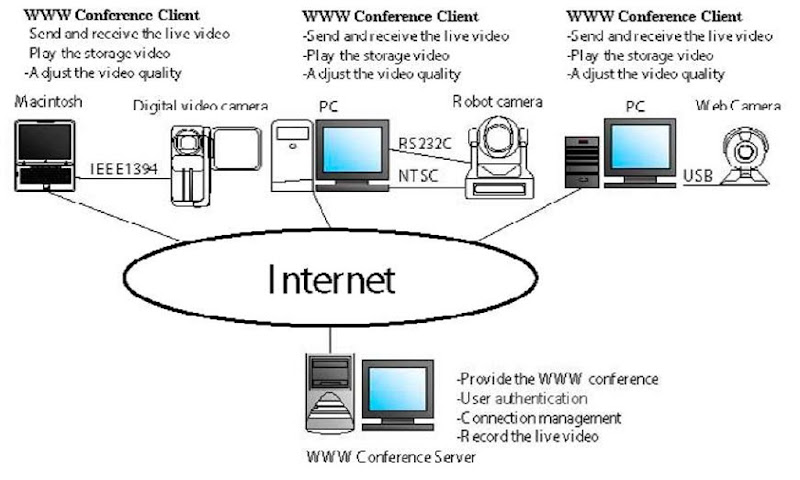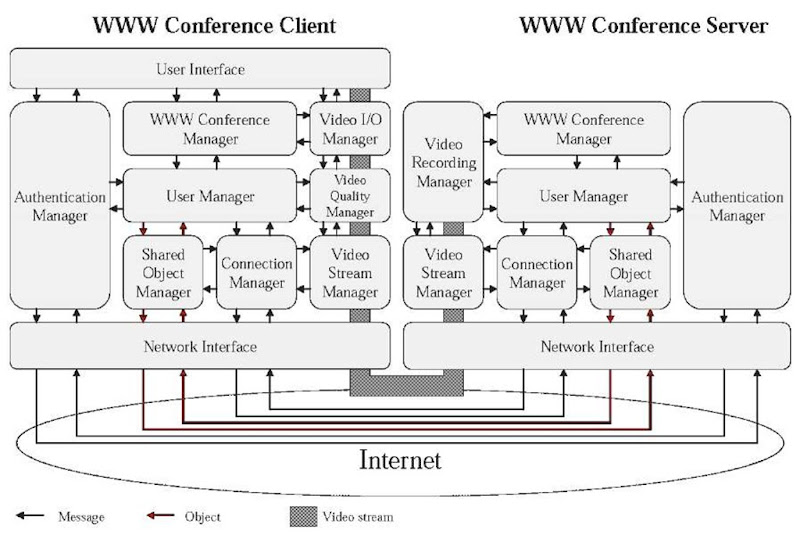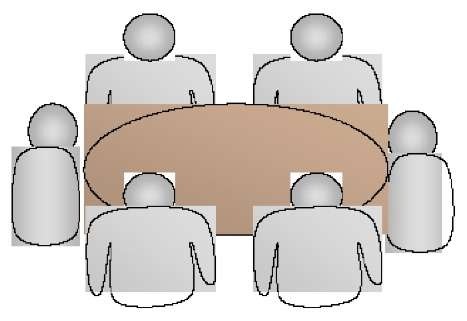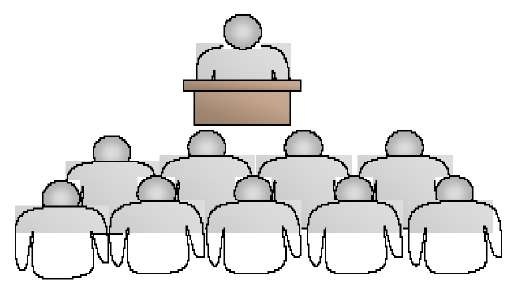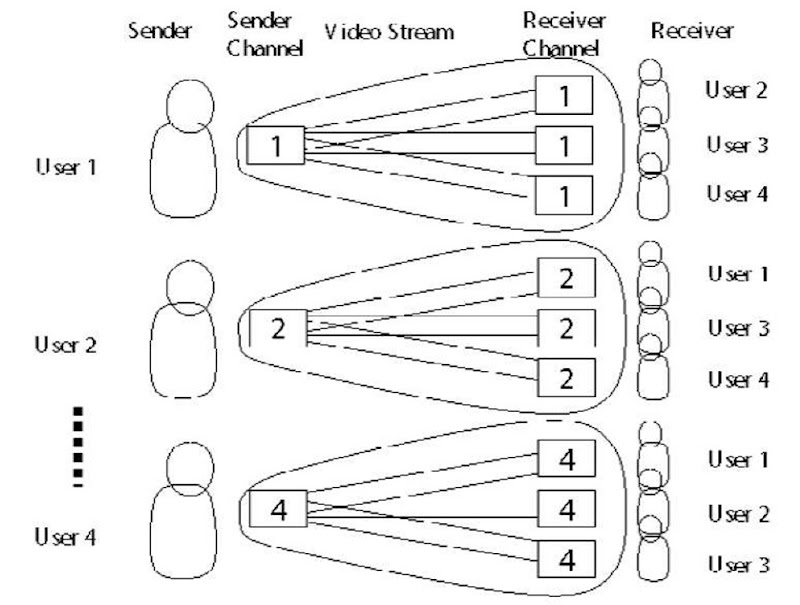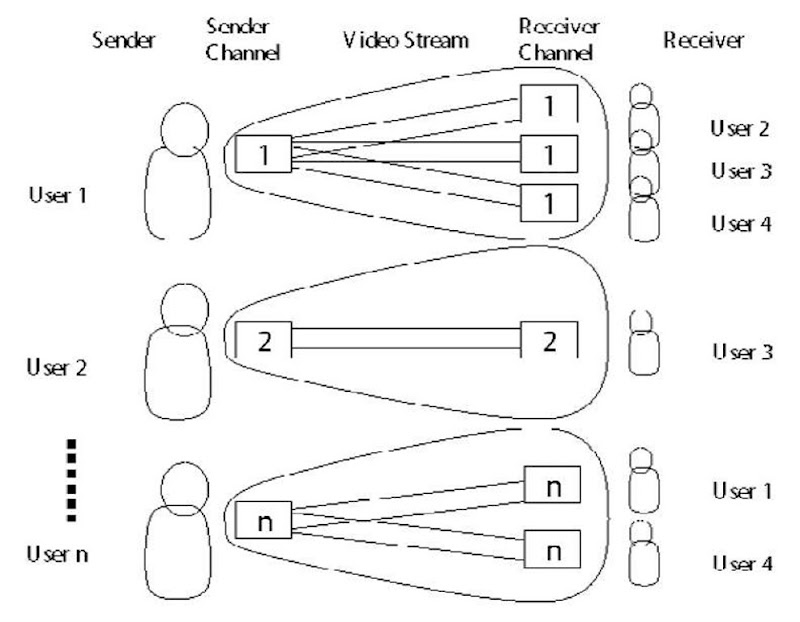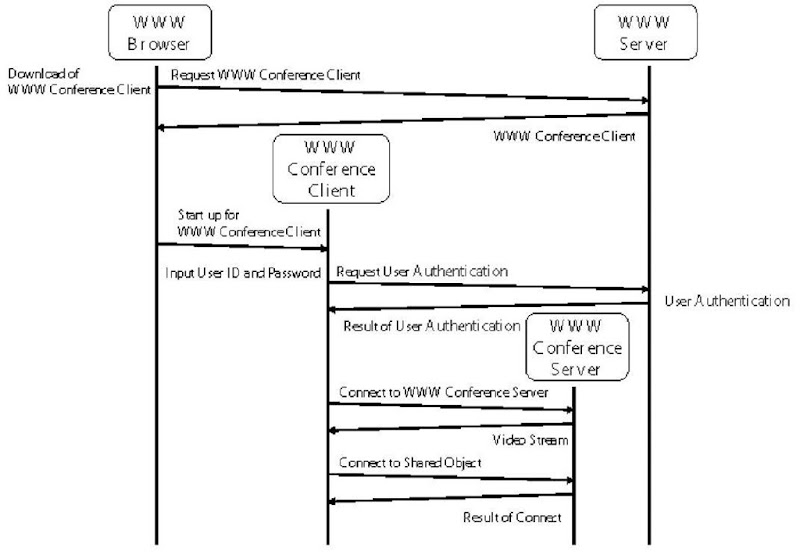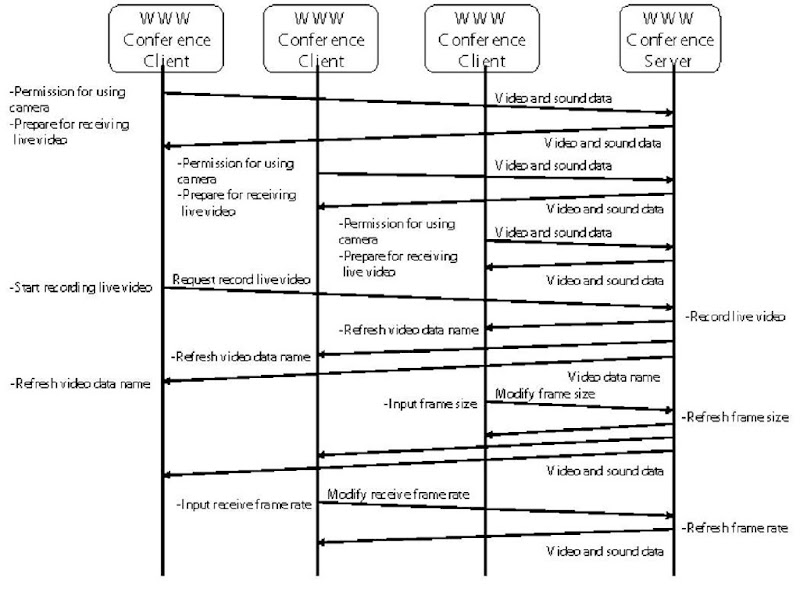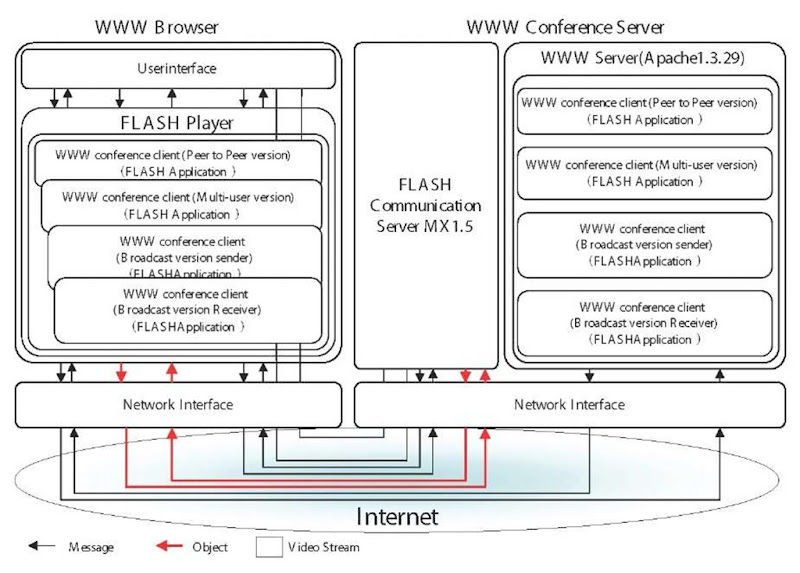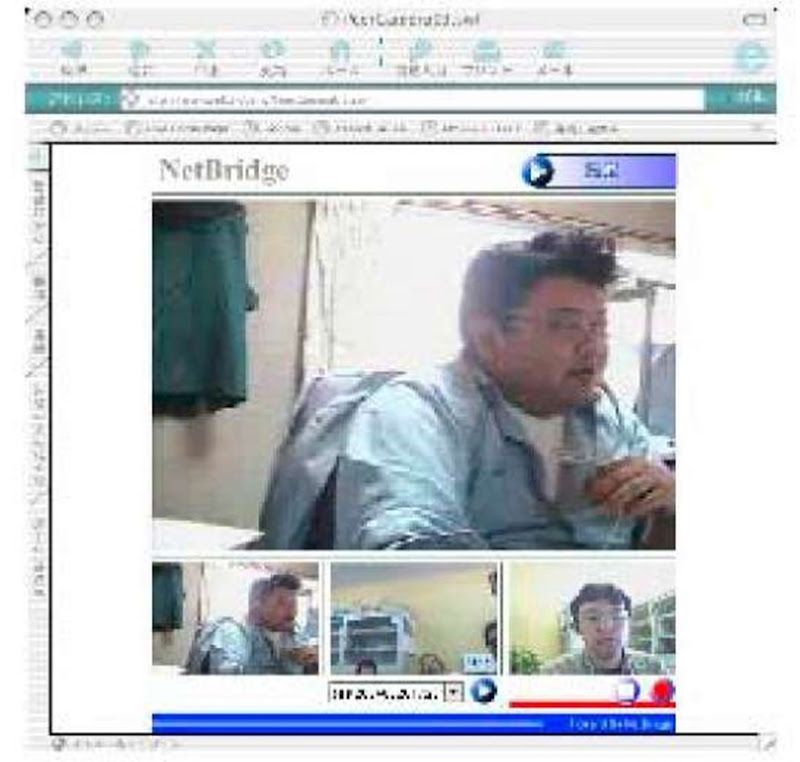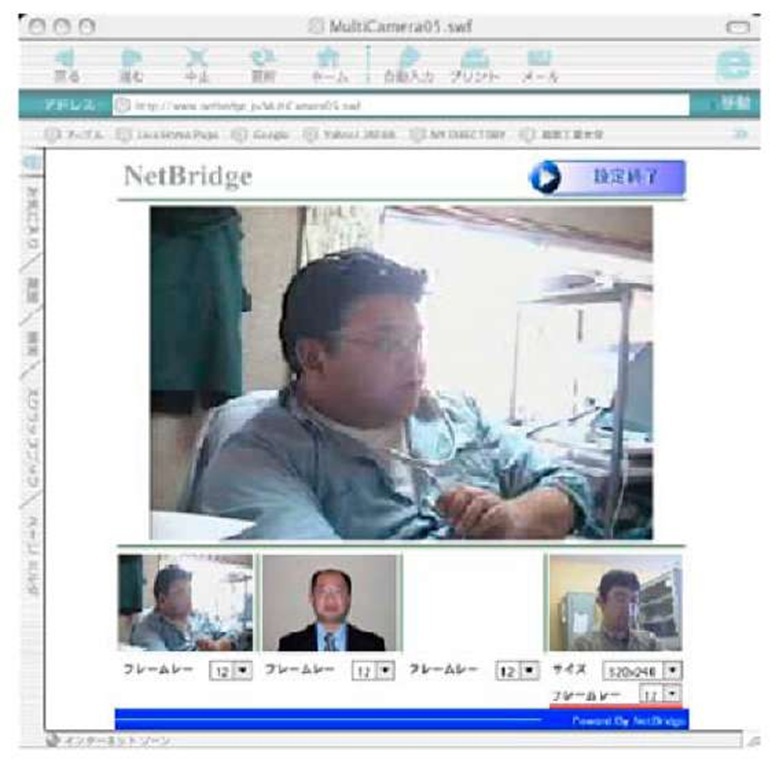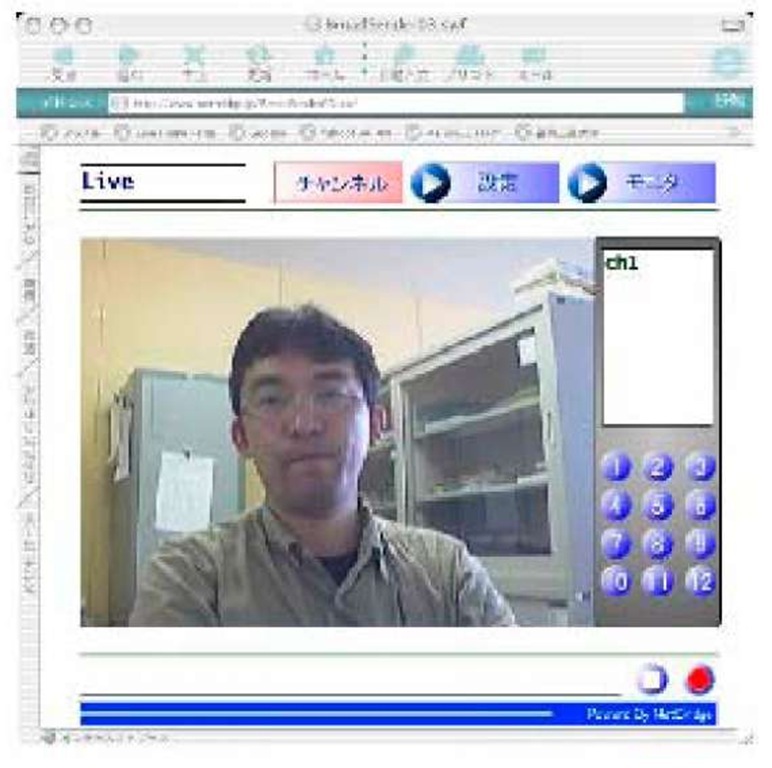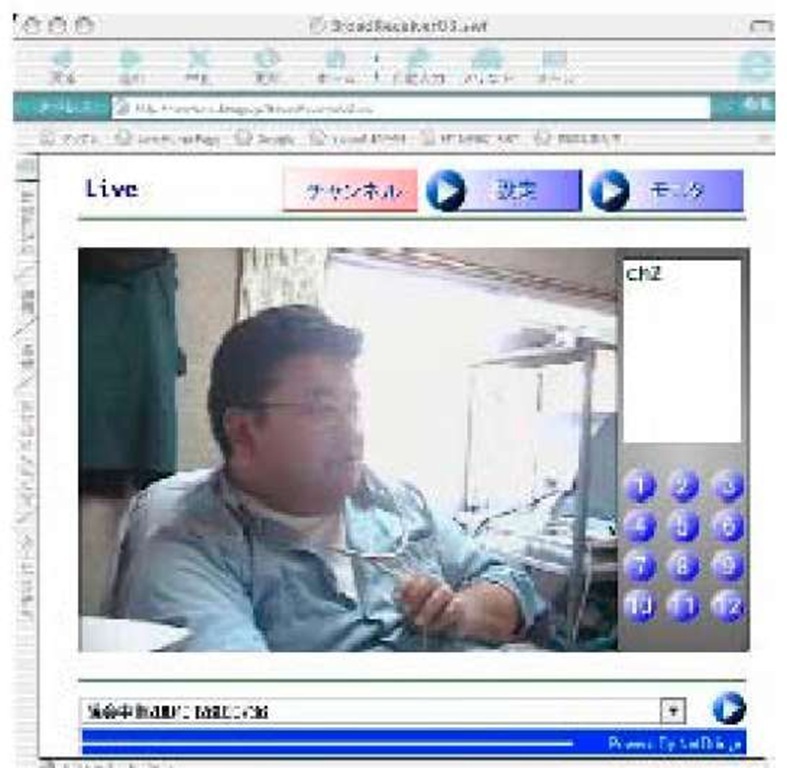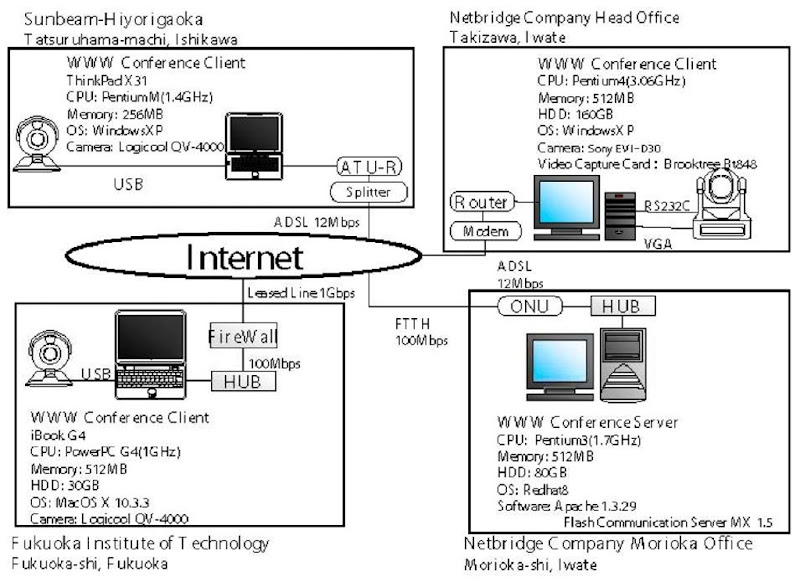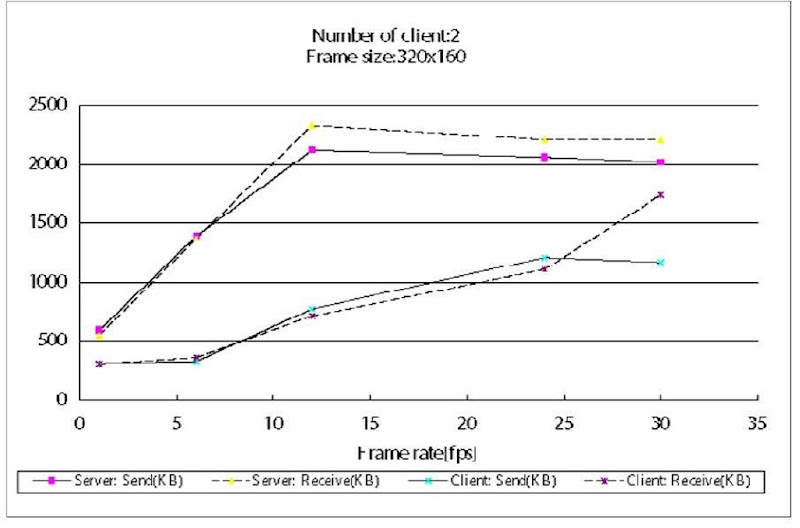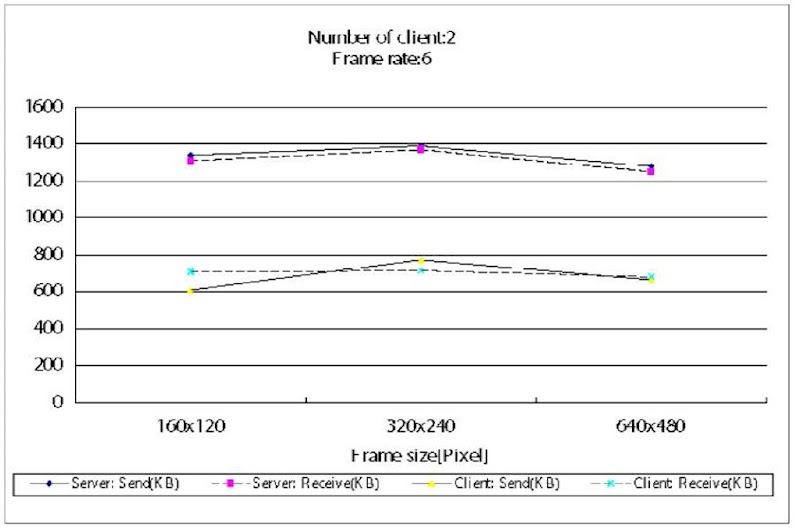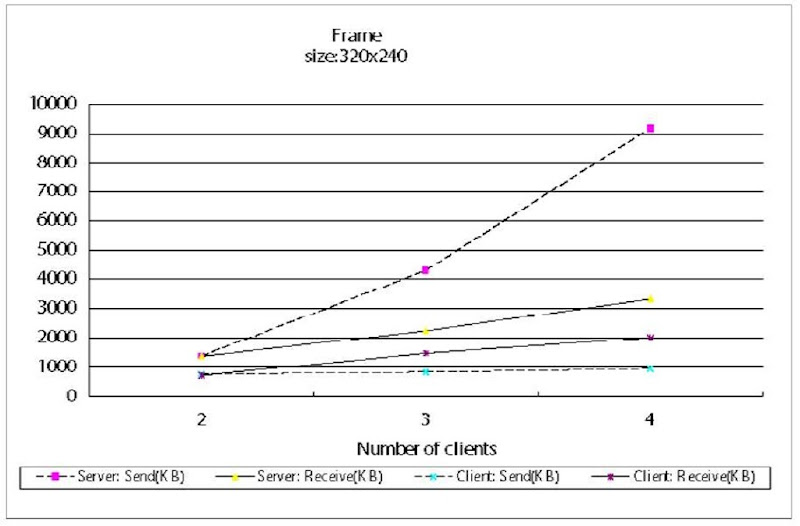ABSTRACT
Information technology (IT) has changed our lives and many applications are based on IT. IT can be helpful for remote mental health care education. Because there are very few mental health care specialists, it is very important to decrease their moving time. But it is not easy to use the conventional TV conference systems for ordinary people, mental health care specialists, and their students because they are not computer specialists. For this reason, we have developed a WWW conference system. Our system can communicate between the mental health care specialists and their students by using the live video on WWW browser. In this paper, we show the implementation and the evaluation of proposed system. The experimental results over the Internet show that our system can be used for real time communication between Fukuoka, Ishikawa, and Iwate prefectures.
INTRODUCTION
Recently in Japan, mental health care has become a very important issue because there are many people suffering from mental problems. Also, there are only a few specialists and researchers to deal with these problems. For example, bullying at school is one of the big problems worrying teachers in Japan today. Also, there are other problems such as refusal to go to school and school violence. However, there are few counselors in Japanese schools. It should be noted that many of these specialists are also doing other works. In general, one mental health care specialist should take care for many patients and they want to see their face. They should take care of not only the counseling but also the individual aftercare.
Information technology (IT) has changed our lives. People can communicate between themselves and students can study various courses at anywhere and anytime using the Internet. IT can be helpful for mental health care, education, aftercare, and counseling for patients and their families. Because there are very few mental health care specialists, it is very important to decrease their moving time. Also, it is very important to see the facial expression and to talk to people for mental health care education, aftercare, and counseling. For this reason, the video and voice are needed.
Recently, because of the use of ADSL and FTTH (NTT West, 2004) many people can use several Mbps on the Internet. Therefore, many people can use the streaming live video and TV conference. For example, the streaming live video is used for the tourist attractions broadcasting (Fuji-shi, 2005; Kumamoto-shi, 2001; Sapporo-shi, 2004), assembly broadcasting (The House of Councilors, 2005; The House of Representatives, 1999;), and public information broadcasting (The ministry of public management, 2004). In these live streaming video methods, the image refreshed at regular intervals over WWW (Fuji-shi, 2005; Kumamoto-shi, 2001; Sapporo-shi, 2004) and RealPlayer or Windows Media Player (The House of Councilors, 2005; The House of Representatives, 1999; The Ministry of Public Management, 2004) are used.
Some TV conference systems are used as special hardware (NEC Engineering, 1996; Polycom, 2004; SONY, 2004; VTEL, 2004) and in other systems are used as application software or PC connected to the existing cameras (Advanced Solutions, 2001, 2002; Hitachi Hybrid Network, 2004; Microsoft, 2004; Visual Nexus, 2004). When using the special hardware, the users need to connect to the Internet and set up the hardware in each spot before using the system. But, it is difficult to use the special hardware in counseling because the users are usual people. While, when using the application software and PC is connected to the existing camera, the users need to connect the PC and camera, setup the PC, and install the application software in each spot before using the system. Also, it is difficult to introduce these systems for mental health care because the mental health care specialists and their student are not computer specialists.
In order to realize a remote mental health care education, we have developed a WWW conference system. Our system is able to support the communication between the mental health care specialists and their students. Also, our system can provide the communication between the mental health care specialists, patients, and their families by using the live video on WWW browser, point to point communication, point to multi-point communication, and multi-point to multi-point communication.
The organization of this article is as follows. In the next section, we will introduce the related works. Next, we describe the WWW conference system and explain system architecture. The conference types are treated in the following section. After that, we show the connection management for each conference type and the flow of WWW conference system. Then, we show implementation of our proposed system by using Macromedia Flash and Macromedia Flash Communication Server and provide the experimental results. Finally, we give some conclusions and future works.
RELATED WORK
Existing communication systems are usually realized on the LAN environment and leased lines. Many remote education systems are proposed in Inoue, Okada, and Matsushita (1997), Mori, Oyabu, Nomura, and Oshita (1992), Sa-kiyama, Ohono, Mukunoki, and Ikeda (2001), and Wakahara (1998). In Inoue et al. (1997) and Wakahara (1998), the multi-point to multi-point communication is used. While in Sakiyama et al. (2001), a video stream selection according to lecture context is proposed. In these systems, the remote users can communicate between them using the live video.
Recently, the live video communication systems have become very popular and the network speed is increased very fast. Therefore, the video conference systems can be applied in the medical field. There are many video conference systems such as the medical tele-consultation support system using super high definition imaging system (Yamaguchi et al., 2001), remote medical support system using the transcoding function (Kawamura, Maita, Hashimoto, & Shibata, 2003), and care communications service between hospitalized patients and their families (Abiko, Iijima, Koyama, Kamibayashi, & Narita, 2003). In these studies, the system was implemented only for intranet or leased lines.
Some other communication systems using live video for remote learning systems (Maeda et al., 1997; Miyoshi, Okanaga, Kou, & Kondo, 2000) and streaming video (Kato, Jiang, & Hakozaki, 2003) has been proposed. In the multimedia communication environment for distance learning proposed in Maeda et al. (1997) are given the experimental results for remote learning using intranet and Internet environments. In this study is shown that an efficient remote learning can be achieved by using 600 Kbps bandwidth. Now, Internet users can have more bandwidth by using ADSL and FTTH. And the live video over the Internet is possible. In Kato et al. (2003), the authors propose a streaming video system for best-effort networks using adaptive QoS control rules to improve the satisfaction of streaming video services.
Figure 1. WWW conference
However, these systems can’t be used by usual people and they need special hardware and software. These systems use point to point communication, so they can not be used for multipoint to multi-point communication. In order to overcome these problems, we have developed a WWW conference system, which uses multi-point to multi-point communication and can transmit live video over the Internet.
PROPOSED WWW CONFERENCE SYSTEM
The proposed WWW conference system is shown in Figure 1. If the user has a video camera and PC connected to the Internet, the user can communicate to the remote users by using live video on WWW. Using our system, the user does not need to install and setup the application software. He just only needs to access the WWW conference server by using the WWW browser.
The concept of WWW conference is shown in Figure 2. The user can use various cameras such as the WWW camera, digital video camera and robot camera. But, the camera should be identified and connected to the PC. Our system is composed of the WWW conference client and the WWW conference server. When the user accesses the WWW conference server by using a WWW browser, the WWW conference client is downloaded to the PC. After downloading the WWW conference client, the system provides the following functions:
1. User authentication
2. Live video function
3. Video record function
4. Quality setting function
The user authentication function is provided by user ID and password. When the user enters into the WWW conference server, the user inputs its user ID and password. The user ID and password are compared with the registered ones in the WWW conference server. When the user ID and password do not match, the user login fails and the user needs to input again its user ID and password. It should be noted that the user login may fail when the WWW conference server has already logged on the maximum number of users.
Figure 2. WWW conference system
The live video function provides the video data and voice data. The video data and voice data are sent and received by the video stream. They are encoded by H.263. Our system provides three types of conference using this function. In order to realize the live video, the WWW conference client has the connection management function, the video encode function, and the video decode function. The WWW conference server has the connection management function.
The video record function records the live video stream and plays the recorded video stream on the WWW conference server. The user can record the live video stream and play the recorded video stream by using the WWW conference client. The recorded video stream is stored in the WWW conference server. The recorded video stream is used for learning the existing cases of counseling and replaying the instructions for mental health care.
The quality setting function modifies the video quality for local WWW conference client and remote WWW conference client. The local WWW conference client can modify the video size and frame rate. But, the remote WWW conference client can modify only the frame rate. When the PC does not have enough CPU power or network bandwidth, the voice data are delayed and video data experiences frame loss and frame delay. However, our system can guarantee the quality of service such as “Frame rate is high and video size is small” and “Frame rate is low and video size is large” when the user modifies the video quality using this function.
SYSTEM ARCHITECTURE
In order to implement our system, we propose a system architecture, which is organized by the WWW conference client and the WWW conference server as shown in Figure 3.
WWW Conference Client
Presently, various network environments exist, such as broadband network and narrowband network. The bandwidth varies from 10 Kbps to 100 Mbps. In order to realize the communication between various network environments, the WWW conference client is organized by User Interface (UI), Authentication Manager (AM), User Manager (UM), WWW Conference Manager (WCM), Connection Manager (CM), Shared Object Manager (SOM), Video I/O Manager (VI/OM), Video Quality Manager (VQM), and Video Stream Manager (VSM).
The UI provides the following functions:
1. Insertion of user ID and password
2. Setup of video input and output device
3. Display of live video
4. Modification of video quality
The AM authenticates the user ID and password by using the registered user ID and password on the WWW conference server. When the AM fails for the authentication, the AM requests the user ID and password to the user again. When the AM authentication is a success for the authentication, the AM sends the user ID to the UM. The UM manages the system users, the video quality for each video stream and the name of the recorded video stream. When maximum number of users has been logged in to the WWW conference server, the UM rejects other users. The WCM sets up the number of maximum users and provides the user interface. The maximum number of users and the user interface are decided by the conference type. The CM manages the connections of the other WWW conference clients participating in the tWionW. W conference. The CM converts the number of maximum users to the number of maximum conSections. The SOM gets the shared object from the WWW conferenc e server. The recorded video stream is played Iwy using; thn video name. We use the shared object to record the name of video stream on the WWW conference server. When the user wants to record the live video stream through the UI, the SOM adds the name of video stream as the shared object to the WWW conference server. The VI/OM inputs the video data and sou nd data from the camera and the video stream -s select ed by the WCM. The VI/OM dismays thevideo data and sound data from the video stream and the came ra. A lso, the VI/OM sends the video data and sound data to the VQM. The VQM decides the frame rate and the size of video by usinge ohe identified video quality. The VSM senMs and receives t he video data and voice datn as the video stream to the WWW conference serveh. The other WWW confe rence clients operate in the same way.
Figure 3. System architecture
WWW Conference Server
In order tea realize the WWW conference and record the live video stream, it is needed to manage the vi deo s/reem includmg live video stream and recor^d video stream. So , the WWW con-ferenceserver is organized ley the AM, WCM, UM, CM, SOM, Video R^ord Manager (VRM), and VSM. The AM manuges the uner ID and passwo rd. It compares the user I D and password with the registered user ID anml password when the AM requests the authentication from the WWW conference clie nt. The UM manages the users mside the system, the video quality for each video stream and the name of the recorded video stream. The WCM manages the user and video stream based on type of conference. The CM manages the connect ion o° the WWW conference clients. The n, ht decides t he numbee of maximum connections by using the number oh maximum users. When the WWW couference server has already the maximum number of users, the CM rejects the new conneotion. The SOM stores the shared object, which is the name of video stream on the WWW conference server. The shared object remains even after disconnecting the WWW conference client. The VRM records and manages the video stream on the WWW conference server. The VSM manages the video stream between the WWW conference clients and the WWW conference server.
TYPE OF CONFERENCES
For the remote mental health care education are needed various conference types. We introduce three conference types because our system is used for the counseling, aftercare, and education.
Point to Point Conference
The point to point conference is used for counseling the patients. The point to point conference provides functions for point to point communication as shown in Figure 4. This type displays the local live video stream and the remote live video stream. The user can record the local live video stream and play the recorded video stream. Using the point to point conference, the patient can take the counseling at home.
Multi-User Conference
The multi-user conference is used for aftercare. The multi-user conference provides functions for the multi-point to multi-point communication as shown in Figure 5. In the multi-users conference, the users can communicate in a distributed way at the same time. This is why the local video stream and the multiple remote live video streams can be display at the same time. By using the multi-user conference, the patient and their family members can talk together with psychology specialists even if they are not at the same place.
Figure 4. Point to point conference
Figure 5. Multi-user conference
Figure 6. Broadcast conference
Broadcast Conference
The broadcast conference is used for health care education. It provides broadcast functions to broadcast the live video to many users as shown in Figure 6. This method is used for live broadcast (The House of Councilors, 2005; The House of Representatives, 1999). The broadcast conference uses two types of WWW conference clients: the sender and receiver clients. The sender client displays the local live video, selects the sending channel, sends the live video stream to receiver client, and records the local live video stream. The receiver client selects the receiver channel, receives and displays the video stream and plays the recorded video stream. Using the broadcast conference, the students can learn the clinical psychology, the family and patient can learn the mental health care at home.
CONNECTION MANAGEMENT
In order to provide the live video for distributed users, the video data and voice data are transmitted in the video streams. The number of video streams is decided based on the type of conference and the number of users. The WWW conference client can be connected to the remote WWW conference client via WWW conference server to create the video stream. Our system uses the channel to create and manage the video stream. Each channel has a channel number. The channel number is used for the clients connection and selection of the video stream. In the point to point conference and multi-user conference, the channel numbers are assigned based on the connection order. While, in the broadcast conference, the channel numbers are selected by the user.
An example of the relation between the video stream and channel number in the point to point conference is shown in Figure 7. This conference uses two video streams in each WWW conference client. One is used for the sender client and another for the receiver client. The sender video stream and receiver video stream have different channel numbers. After allocating the channel number, the WWW conference client creates the video streams by using the channel number.
In this example, the user 1 is connected to the WWW conference server before the user 2. For this reason, the channel number starts from 1. The channels 1 and 2 are shown in Figure 7. In the channel 1, the user 1 is the sender and the user 2 is the receiver of the video stream. While, in the channel 2, the user 2 is the sender and the user 1 is receiver.
The relation between the video stream and channel number in the multi-user conference is shown in Figure 8. In this type, each user has its own video stream. The channel number is assigned the same as type one. After allocating the channel number, the WWW conference client creates the video stream for each receiver.
In this example, four users are connected to WWW conference server. In the channel 1, the user 1 is the sender and the users 2, 3 and 4 are receivers. Each WWW conference client creates the video streams by using these channel numbers.
The relation between the video stream and channel number in the broadcast conference is shown in Figure 9. The user can select the sender channel number using the sender client. Then, the video stream is created based on the selected channel number. Also, the user can select the receiver channel number using the receiver client. It should be noted that a user can not send the video stream in a channel when this channel is used by another user. But, the receivers can get the same channel at the same time. When the sender channel number has already been used, the WWW conference client displays this message: “This channel number has already been used.”
Figure 7. Connection management for point to point conference
Figure 8. Connection management for multi-user conference
Figure 9. Connection management for broadcast conference
WWW CONFERENCE OPERATION
The WWW conference operation has two phases: the start up phase and live video communication phase. In the start up phase, the WWW conference client is downloaded and the user enters into the WWW conference server using the WWW browser. The live video communication phase consists of camera setup, video quality modification, and sending and receiving the live video.
Figure 10. Startup phase
The start up phase is shown in Figure 10. First, the user downloads the desired type of the WWW conference client from the WWW conference server. After that, the WWW conference client starts up automatically and requires the user ID and password. When the user inputs the user ID and password, the WWW conference client sends this information to the WWW conference server to authenticate the user. When the authentication fails, the WWW conference client requests the user ID and password again. When the authentication is a success, the WWW conference client creates the video streams. Then, the WWW conference client connects to the shared object to share the name of recorded video stream with other WWW conference clients.
The live video communication phase is shown in Figure 11. First, the WWW conference client asks the user for the permission to use the camera. Next, the WWW conference client allocates the channel number to send and receive the live video stream. When the WWW conference client finishes the channel allocation, it starts to send/receive the live video streams to/from other clients via WWW conference server. When the user requests to record the live video stream, the WWW conference client sends this request to the WWW conference server.
The WWW conference server adds the new name of live video stream to the shared object. Then, the name of live video stream is added to the connected WWW conference clients. When the user inputs the frame size, the WWW conference client updates the frame size, modifies the captured frame size and sends the modified frame size to the WWW conference server. When the WWW conference server receives the modified frame size, it updates the new frame size and sends the live video stream to the WWW conference clients using the new frame size. Also, the frame rate is updated the same as the frame size.
Figure 11. Live video communication phase
IMPLEMENTATION
The implemented system structure is shown in Figure 12. The WWW conference client is implemented by using the Macromedia Flash Studio MX1.5. The WWW conference server is realized by using the Apache1.3.29 and the Macromedia Flash Communication Server MX1.5. The Apache1.3.29 is used to provide the WWW conference client to the users. The Macromedia Flash Communication Server MX1.5 is used for sending and receiving the video data and voice data. The live video streams are encoded by H.263. We implemented three types of applications for each type of conference. When the user downloads the desired type of application, the WWW conference client displays the authentication interface. The user can take part in the WWW conference after authentication.
The point to point conference application is shown in Figure 13. The bottom side of interface shows the remote live video, recorded live video, and local live video from left to the right side. The list box and play button are shown below the recorded video. The list box is used to select the name of video stream and play button is used to play the recorded live video stream. The stop button is shown in the left side below the local live video stream. This button is used to stop the recorded live video stream. The record button is shown in the right side below the local live video. The user can record and play the live video stream by using these buttons. The main video display can be selected by clicking one of the videos shown in the bottom side. The video quality setup is shown in the upper side of the interface. The interface also has in the bottom side some list boxes, which are used to change the frame size and frame rate. The frame size can be changed only at the local live video. But, the frame rate can be changed in both: the local live video and remote live video.
Figure 12. Implemented system structure
Figure 13. Point to point conference application
Figure 14. Multi-user conference application
The multi-user conference application is shown in Figure 14. In the bottom side of interface are shown the remote live videos and local live video. The right side displays the local live video. The user can modify the frame rate for each remote live video using the list box. Also, the user can modify the frame rate and frame size for the local live video using the list box.
Figure 15(a). Broadcast conference sender application
The broadcast conference applications are shown in Figures 15(a) and (b). These applications include the channel select interface, video quality set up interface and video display interface.
The sender client interface is shown in Figure 15(a) and the receiver client interface is shown in Figure 15(b). The main video in the center of the display shows the snap shot of the live video captured from the video camera. In the bottom side of interface are shown the text box, stop button and play button. The text box displays the name of recorded video stream. On the right side of the interface are shown the sender channel select buttons. The user can select the channel number from 1 to 12. Also, the user can input the name of live video stream and record the live video on the WWW conference server. When the user pushes the channel select button, the sender client starts to send the live video stream and the name of live video stream using the selected channel number. The video quality set up interface has the list box shown below the video. The user can modify the frame size and frame rate by selecting the values in the list box. The video display interface displays the live video and interface select buttons. The receiver client interface is almost the same with sender client interface, but the sender client interface can record the live video while the receiver client interface can play the recoded video.
Figure 15(b). Broadcast conference receiver application
experiments
Experimental Results
In order to evaluate our system for remote mental health care education, we used our system in a real Internet environment between Fukuoka, Ishikawa, and Iwate prefectures. Our evaluation environment is shown in Figure 16. The LANs are connected to the Internet environment by leased line (1 Gbps), FTTH (100 Mbps) and ADSL (12 Mbps). The experiment showed that the live video quality is good enough for communication. But it should be noted that sometimes the live video quality deteriorates because the bandwidth is not enough to send and receive the live video. In such cases, the frame rate is decrease and voice data is delayed about 1 second. Also, we evaluated the performance of our system on the LAN environment (100 Mbps) to analyze the possibility of realization of remote mental health care. We analyzed the throughput and load average for the multi-user conference. In this experiment, we use low performance computers because usual people use in general low performance computers. We used five PCs in this experiment. One PC is used as WWW conference server and four other ones are used as the WWW conference clients. The PC characteristics are shown in Table 1.
From these results, we conclude that the bandwidth of the LAN environment is enough for our system. But, the PCs should have more power to send, receive and display the live video.
The relation between the frame rate and load average at client side is shown in Table 2 and the relation between the frame rate and throughput is shown in Figure 17. We see that the load average and throughput are affected by the frame rate at client side. But, we found that the throughput is not changed more than 12 fps. This is because the PCs have not enough CPU power and the load average is close to 100%. After that, the throughput remains the same. In this case, the frame is delayed and the load average becomes high.
The relation between the frame size and load average at client side is shown in Table 3 and the relation between the frame size and throughput is shown in Figure 18. We see that the load average is affected by the frame size at client side. But, we found that the throughput is not affected by frame size.
The relation between the number of clients and load average at client side is shown in Table 4 and the relation between the number of clients and throughput is shown in Figure 19. We see that the load average and throughput are affected by the number of clients. Especially, the data sent from the server are affected by the number of clients because each client needs to receive all of live videos except for the own live video. But, the data sent from the client remain the same.
Comparison of Proposed and Conventional Systems
In Table 5 we compare our proposed system with conventional systems considering network environment, implemented platform, hardware/ software, installation and setup, and communication service.
Some of conventional systems can be used not only in LAN environment/leased line, but also in Internet environment. However, these systems don’t run in the multi-platform OSs. Using these systems, each user needs to install and setup the special hardware or software. In some of them is needed only the setup, but each user needs to make installation of special hardware or software. Furthermore, there are few systems, which can be used for point to point, multi-point to multi-point, and broadcast communication.
Table 1. PCs characteristics for performance evaluation
|
|
CPU |
Memory |
OS |
|
Scivcr |
Pctirium4 (l.fiGHz) |
IG |
WindowsXP |
|
Client 1 |
Pentium? (450MHz) |
128M |
Windows2000 |
|
Client 2 |
Pentium? (667MHz) |
128M |
WindowsXP |
|
Client 3 |
Pentium? (664MHz) |
128M |
Windows20OO |
|
Client 4 |
Celeron (700MHz) |
192M |
WindowsXP |
Figure 16. Evaluation environment
Figure 17. Relation between frame rate and throughput
While, our proposed system can be used in real Internet environment, and Windows, Macintosh and Linux OSs. In order to use our system, the user needs only to access the WWW conference server by using the WWW browser. After that, the system is installed and set up automatically. Also, the proposed system supports point to point, multi-point to multi-point and broadcast communication.
Table 2. Relation between frame rate and load average
|
Frame R ate |
1 |
6 |
12 |
24 |
30 |
|
Load Average |
40 |
69 |
87 |
93 |
94 |
Table 3. Relation between frame size and load average
|
Frame Size |
160×120 |
320×240 |
640×430 |
|
Load Average |
30 |
69 |
92 |
Figure 18. Relation between frame size and throughput
Table 4. Relation between number of clients and load average
|
Number of Clients |
2 |
3 |
4 |
|
Load Average |
69 |
76 |
87 |
CONCLUSION
In this article, we proposed a WWW conference system for supporting remote mental health care education. We showed the conference types and connection management methods for realizing each type of conference. We presented the WWW conference operation. Finally, we discussed the implementation and evaluation of our proposed system. From experimental results, we conclude as the follows:
1. The proposed system can provide the same communication between Fukuoka, Ishikawa, Iwate prefectures over the Internet.
2. The WWW conference client can send and receive the live videos for four users in the LAN environment.
3. The WWW conference client needs a high CPU power to send, receive, and display the live video.
Now, we are evaluating the proposed system for different kind of networks and number of hops. In the future, we would like to use the proposed system for mental health care education and counseling.
Figure 19. Relation between number of clients and throughput
Table 5. Comparison of proposed and conventional systems

